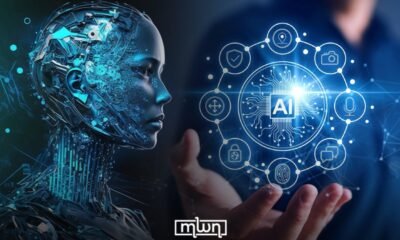Tools & Platforms
Job listings looking for people with AI skills are rising fast

AI gets a lot of attention for eliminating human jobs, but more and more it is also creating them.
The number of job postings that mention artificial intelligence has climbed in recent years as employers seek workers versed in AI, a recent report from the Brookings Institution shows, In the last year alone, AI-themed job postings increased by over 100%, the Washington, D.C.-based think tank found.
AI-related job postings have grown at an average annual rate of nearly 29% over the last 15 years — that outstrips the 11% rate of postings in the general economy, said Brookings, which based its findings on data from labor market analytics firm Lightcast.
Demand for AI expertise is growing as more companies start to integrate AI into their workflows. The share of companies using AI in the manufacturing sector has more than doubled from 4% in early 2023 to roughly 9% as of mid-2025, according to Brookings, citing data from the U.S. Census Bureau’s Business Trends and Outlook Survey (BTOS).
Yet while AI job growth has accelerated in recent years, it makes up only a small fraction of the labor market overall. Investment bank Goldman Sachs estimates the peak pace of adoption will hit in the early 2030s.
“AI is definitely visible in the micro labor market data, but it doesn’t look like it’s driving the overall labor market dynamic,” said Joseph Briggs, a senior global economist at Goldman Sachs.
What sort of AI jobs exist?
The burgeoning AI job market involves a mix of skill sets ranging from advanced AI-specific roles, such as AI engineers, to more general AI-related positions such as software developers, according to Elena Magrini, the global head of research at Lightcast. In 2025, more than 80,000 job postings mentioned generative AI skills, according to the Brookings report, up from 3,780 in 2010.
Cory Stahle, an economist at the Indeed Hiring Lab, said in an email to CBS MoneyWatch that the use of AI by more businesses is spurring demand for consulting jobs, which are intended to help businesses integrate AI into their workflow. Job postings relating to so-called responsible AI jobs, which focus on the ethical use of AI tools in business and society, are also on the rise, according to Indeed.
“In other words, the definition of what it means to be an ‘AI job’ is changing every day as businesses find new and creative ways to incorporate the technology responsibly,” Stahle said.
AI positions may prove an especially appealing sector of the U.S. labor market given that they tend to be associated with higher salaries. Job postings that mention AI skills pay on average 28%, or $18,000, more per year than job postings for similar roles that don’t require AI skills, according to a separate report from Lightcast.
Where are these jobs growing the most?
Unsurprisingly, AI job growth tends to be concentrated in the tech hubs like Silicon Valley. The renown San Francisco area accounts for 13% of all AI-related job postings, while Seattle accounts for 7% according to data from Lightcast.
That being said, AI jobs are starting to diffuse into other parts of the country including the Sunbelt, a wide swath of land that stretches from the Southeast and Southwest, and along the east coast between Boston and Washington, D.C. said Mark Muro, a senior fellow at Brookings Metro. Universities have also been a catalyst for AI job growth, Muro added, given their role in developing talent bases and training students in computer science.
Magrini noted that AI skills are increasingly required in other non-tech fields like marketing, human resources and finance. Over half of job postings requesting AI skills in 2024 were outside IT and computer science, according to Lightcast data. As for the people landing these jobs, they tend work for tech giants like Amazon, Meta, Apple and Google as well as AI companies such as OpenAI, according to Magrini.
While uptake is uneven across geographic areas, Muro said he expects AI adoption by firms to increase more rapidly in the coming years, as the practical use of the technology becomes more obvious to businesses.
“There does seem to be good consensus that this is very important for productivity and that it does really energize regional leaders and business people,” he said.
Tools & Platforms
Why our business is going AI-in-the-loop instead of human-in-the-loop

True story: I had to threaten Replit AI’s brain that I would report it’s clever but dumb suggestions to the AI police for lying.
I also told ChatGPT image creation department how deeply disappointed I was that it could not, after 24 hrs of iterations, render the same high-quality image twice without changing an item on the image or misspelling. All learnings and part of the journey.
We need to remain flexible and open to new tools and approaches, and simultaneously be laser focused. It’s a contradiction, but once you start down this road, you will understand. Experimentation is a must. But it’s also important to ignore the noise and constant hype and CAPS.
How our business’ tech stack evolves
A few years ago, we started with ChatGPT and a few spreadsheets. Today, our technology arsenal spans fifteen AI platforms, from Claude and Perplexity to specialised tools like RollHQ for project management and Synthesia for AI video materials. Yet the most important lesson we’ve learned isn’t about the technology itself. It’s about the critical space between human judgment and machine capability.
The data tells a compelling story about where business stands today: McKinsey reports that 72 percent of organizations have adopted AI for at least one business function, yet only one percent believe they’ve reached maturity in their implementation. Meanwhile, 90 percent of professionals using AI report working faster, with 80 percent saying it improves their work quality.
This gap between widespread adoption and true excellence defines the challenge facing every service organisation today, including our own.
Our journey began like many others, experimenting with generative AI for document drafting and research. We quickly discovered that quality was low and simply adding tools wasn’t enough. What mattered was creating a framework that put human expertise at the center while leveraging AI’s processing power. This led us to develop what we call our “human creating the loop” approach, an evolution beyond the traditional human-in-the-loop model. It has become more about AI-in-the-loop for us than the other way round.
The distinction matters.
Human-in-the-loop suggests people checking machine outputs. Human creating the loop means professionals actively designing how AI integrates into workflows, setting boundaries, and maintaining creative control. Every client deliverable, every strategic recommendation, every customer interaction flows through experienced consultants who understand context, nuance, and the subtleties that define quality service delivery.
Our evolving tech stack
Our technology portfolio has grown strategically, with each tool selected for specific capabilities.
Each undergoes regular evaluation against key metrics, with fact-checking accuracy being paramount. We’ve found that combining multiple tools for fact checking and verification, especially Perplexity’s cited sources with Claude’s analytical capabilities, dramatically improves reliability.
The professional services landscape particularly demonstrates why human judgment remains irreplaceable. AI can analyse patterns, generate reports, and flag potential issues instantly. But understanding whether a client concern requires immediate attention or strategic patience, whether to propose bold changes or incremental improvements; these decisions require wisdom that comes from experience, not algorithms.
That’s also leaving aside the constant habit of AI generalising, making things up and often blatantly lying.
For organisations beginning their AI journey, start with clear boundaries rather than broad adoption.
Investment in training will be crucial.
Research shows that 70 percent of AI implementation obstacles are people and process-related, not technical. Create internal champions who understand both the technology and your industry’s unique requirements.
Document what works and what doesn’t. Share learnings across teams. Address resistance directly by demonstrating how AI enhances rather than replaces human expertise.
The data supports this approach. Organisations with high AI-maturity report three times higher return on investment than those just beginning. But maturity doesn’t mean maximum automation. It means thoughtful integration that amplifies human capabilities.
Looking ahead, organisations that thrive will be those that view AI as an opportunity to elevate human creativity rather than replace it.
Alexander PR’s AI policy framework
Our approach to AI centres on human-led service delivery, as outlined in our core policy pillars:
- Oversight: Human-Led PR
We use AI selectively to improve efficiency, accuracy, and impact. Every output is reviewed, adjusted, and approved by experienced APR consultants – our approach to AI centres on AI-in-the-loop assurance and adherence to APR’s professional standards.
- Confidentiality
We treat client confidentiality and data security as paramount. No sensitive client information is ever entered into public or third-party AI platforms without explicit permission.
- Transparency
We are upfront with clients and stakeholders about when, how, and why we use AI to support our human-led services. Where appropriate, this includes clearly disclosing the role AI plays in research, content development, and our range of communications outputs.
- Objectivity
We regularly audit AI use to guard against bias and uphold fair, inclusive, and accurate communication. Outputs are verified against trusted sources to ensure factual integrity.
- Compliance
We adhere to all applicable privacy laws, industry ethical standards, and our own company values. Our approach to AI governance is continuously updated as technology and regulation evolve.
- Education
Our team stays up to date on emerging AI tools and risks. An internal working group regularly reviews best practices and ensures responsible and optimal use of evolving technologies.
This framework is a living document that adapts as technology and regulations evolve. The six pillars provide structure while allowing flexibility for innovation. We’ve learned transparency builds trust. Clients appreciate knowing when AI assists in their projects, understanding it means more human time for strategic thinking.
Most importantly, we’ve recognised our policy must balance innovation with responsibility. As new tools emerge and capabilities expand, we evaluate them against our core principle: does this enhance our ability to deliver exceptional service while maintaining the trust our clients place in us?
The answer guides every decision, ensuring our AI adoption serves our mission rather than defining it.
For more on our approach and regular updates on all things AI reputation, head to Alexander PR’s website or subscribe to the AI Rep Brief newsletter.
Tools & Platforms
A Scalable Blueprint for Tech-Enhanced ROI

In the high-stakes arena of general merchandise retail, Walmart has emerged as a trailblazer, leveraging artificial intelligence not just as a buzzword but as a strategic engine for scalable returns. From 2023 to 2025, the company has systematically embedded AI into its DNA, creating a blueprint for how retailers can achieve operational efficiency, cost savings, and customer loyalty in an era of razor-thin margins. For investors, this isn’t just a story of technological innovation—it’s a masterclass in how to turn AI into a profit center.
The AI Arsenal: From “Super Agents” to Digital Twins
Walmart’s AI playbook is as diverse as it is precise. At the heart of its transformation are four “super agents” designed to streamline interactions across the retail value chain:
– Sparky (for shoppers): This AI agent anticipates customer needs by analyzing household behaviors, seasonal trends, and purchase history. It doesn’t just recommend products—it crafts personalized shopping baskets and automates reordering, reducing the “mental load” on consumers.
– Marty (for sellers and suppliers): By consolidating vendor onboarding, inventory coordination, and promotional planning, Marty cuts administrative overhead and accelerates decision-making.
– Associate Agent (for employees): This tool acts as a one-stop shop for store associates, handling payroll, time-off requests, and real-time sales insights. It even learns from user interactions, becoming more intuitive over time.
– Developer Agent (for systems): Accelerating software development by automating routine coding tasks, this agent ensures Walmart’s tech stack evolves at breakneck speed.
But the real magic lies in Walmart’s use of digital twin technology. By creating virtual replicas of its stores, powered by spatial AI, the company can predict and resolve issues like refrigeration failures up to two weeks in advance. This has already slashed emergency alerts by 30% and maintenance costs by 19% in the U.S. Imagine the ripple effect of such proactive problem-solving across 5,500 stores.
Logistics and Delivery: AI’s Invisible Hand
Walmart’s Dynamic Delivery algorithm is another crown jewel. By analyzing traffic, weather, and historical data, it predicts delivery windows with 93% accuracy, enabling same-day delivery to 93% of U.S. households. This isn’t just convenience—it’s a 25% year-over-year boost in digital sales and a 35% surge in Walmart+ memberships. Meanwhile, the Load Planner and Pallet Builder systems optimize trailer loading and route planning, saving $75 million annually in logistics costs.
The financials tell a compelling story. Walmart’s AI-driven advertising platform, Walmart Connect, grew 46% globally in Q2 2025, tapping into the high-margin potential of data-driven marketing. With 27.3 million Walmart+ members, the company is uniquely positioned to monetize customer data without sacrificing privacy—a critical edge in an age where trust is currency.
Why This Matters for Investors
Walmart’s approach to AI is surgical. Unlike companies that dabble in flashy tech, Walmart has focused on solving real-world retail challenges—inventory accuracy, labor efficiency, and customer retention. The results? A 26% year-over-year earnings per share (EPS) growth projection by 2027 and a P/E ratio that’s more attractive than Amazon’s despite stronger e-commerce margins.
The company’s capital allocation is equally impressive. A $520 million investment in Symbotic’s AI-powered robotics and a $19 billion annual capex in the U.S. signal long-term commitment. These aren’t just expenses—they’re investments in infrastructure that will compound value as AI adoption scales.
The Road Ahead: A Retail Renaissance
Walmart’s AI-led transformation isn’t just about today—it’s about redefining the future of retail. The company is already testing agentic AI systems that can autonomously manage complex tasks, from dynamic pricing to in-store navigation. With a proprietary large language model (Wallaby) trained on decades of retail data, Walmart’s predictive capabilities are unmatched.
For investors, the key takeaway is clear: Walmart is not just keeping up with the AI revolution—it’s leading it. While competitors like Amazon and Target are still figuring out how to integrate AI into their operations, Walmart is already reaping the rewards of a disciplined, data-driven strategy.
Final Call to Action
The numbers don’t lie. Walmart’s AI initiatives have delivered $75 million in annual savings, 46% growth in high-margin advertising, and a 1.2–1.5 percentage point boost in operating margins by 2027. For those seeking exposure to the next phase of retail innovation, Walmart offers a rare combination of scale, execution, and profitability.
In a sector where margins are under constant pressure, Walmart’s AI-driven efficiency is a moat worth betting on. This isn’t just a stock—it’s a glimpse into the future of retail, where technology isn’t just a cost center but a catalyst for exponential returns.
Bottom line: Buy Walmart. The AI revolution is here, and Walmart is the blueprint.
Tools & Platforms
AI: The new frontier at the Institute for Continued Learning in St. George – St. George News
-
Tools & Platforms3 weeks ago
Building Trust in Military AI Starts with Opening the Black Box – War on the Rocks
-

 Business2 days ago
Business2 days agoThe Guardian view on Trump and the Fed: independence is no substitute for accountability | Editorial
-

 Ethics & Policy1 month ago
Ethics & Policy1 month agoSDAIA Supports Saudi Arabia’s Leadership in Shaping Global AI Ethics, Policy, and Research – وكالة الأنباء السعودية
-

 Events & Conferences3 months ago
Events & Conferences3 months agoJourney to 1000 models: Scaling Instagram’s recommendation system
-

 Jobs & Careers2 months ago
Jobs & Careers2 months agoMumbai-based Perplexity Alternative Has 60k+ Users Without Funding
-

 Education2 months ago
Education2 months agoVEX Robotics launches AI-powered classroom robotics system
-

 Funding & Business2 months ago
Funding & Business2 months agoKayak and Expedia race to build AI travel agents that turn social posts into itineraries
-

 Podcasts & Talks2 months ago
Podcasts & Talks2 months agoHappy 4th of July! 🎆 Made with Veo 3 in Gemini
-

 Podcasts & Talks2 months ago
Podcasts & Talks2 months agoOpenAI 🤝 @teamganassi
-

 Mergers & Acquisitions2 months ago
Mergers & Acquisitions2 months agoDonald Trump suggests US government review subsidies to Elon Musk’s companies






















